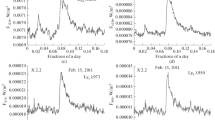Abstract
The large (X-ray class > M1) and very large (X-ray class > X1) flares (according to the observations of GOES-15 and Preliminary data from Current Catalog of Flare Events) in solar activity cycle 24 were analyzed. The monthly average values of optical Flare Index for 2010–2016 were calculated. The values of the total energy of the flare E (J m–2) in the 0.1–0.8 nm range at the level of the earth’s atmosphere were estimated. The energy spectrum (the dependence of the number of flares with the full energy E from the value of this full energy) for 115 flares of M5–X7 classes was built. The comparative study of monthly average values of several indices of solar activity in current cycle 24–the relative sunspot numbers (SSN), the 10.7 cm radio flux (F10.7), the radiation flux in the Lyman-alpha line (FLy-α), the solar constant (TSI) and the Flare Index (FI)–was made.
Similar content being viewed by others
References
Atac, T., Time variation of the flare index during the 21st solar cycle, Astrophys. Space Sci., 1987, vol. 135, pp. 201–205.
Avakyan, S. and Voronin, N., The energetics of climate change, Akad. Energ., 2012, vol. 5, pp. 24–35.
Bruevich, E., Bruevich, V., and Yakunina, G., Changed relation between solar 10.7-cm radio flux and some activity indices which describe the radiation at different altitudes of atmosphere during cycles 21–23, J. Astrophys. Astron., 2014, vol. 35, no. 1, pp. 1–15.
Bruevich, E. and Yakunina, G., General trends in the change in solar activity indices in the period from the late XXto early XXI century, Geomagn. Aeron. (Engl. Transl.), 2015, vol. 55, no. 8, pp. 1060–1065.
NOAA NGDC space weather, solar indices data, 2016. http://www.ngdc.noaa.gov/stp/space-weather/solar-data/solar-indices.
Hudson, H., Solar flares, microflares, nanoflares, and coronal heating, Sol. Phys., 1991, vol. 133, pp. 357–369.
Khlystov, A.I., Distribution of strong and super flares by phases of solar activity cycles, Izv., Atmos. Ocean. Phys., 2014, vol. 50, no. 8, pp. 776–781.
Lemen, J.R., Title, A.M., Akin, D.J., et al., The Atmospheric Imaging Assembly (AIA) on the Solar Dynamics Observatory (SDO), Sol. Phys., 2012, vol. 275, pp. 17–40.
Nagovitsyn, Y., Pevtsov, A., and Livingston, W., On a possible explanation of the long-term decrease in sunspot field, Astrophys. J. Lett., 2012, vol. 758, pp. L20–L24.
Nusinov, A. and Kazachevskaya, T., Extreme ultraviolet and X-ray emission of solar flares as observed from the CORONAS-F spacecraft in 2001–2003, Sol. Syst. Res., 2006, vol. 40, pp. 111–116.
Pevtsov, A., Nagovitsyn, Y., Tlatov, A., and Rybak, A., Long-term trends in sunspot magnetic fields, Astrophys. J. Lett., 2011, vol. 742, pp. L36–L40.
Pevtsov, A., Bertello, L., Tlatov, A., Kilcik, A., and Nagovitsyn, Y., Cyclic and long-term variation of sunspot magnetic fields, Sol. Phys., 2014, vol. 289, pp. 593–602.
Qiu, J. and Longcope, D., Long duration f lare emission: Impulsive heating or gradual heating?, 2016. https://arxiv.org/abs/1604.05342.
Schrijver, C., The nonpotentiality of coronae of solar active regions, the dynamics of the surface magnetic field, and the potential for large flares, 2016. https://arxiv.org/ abs/1602.07244.
Sharykin, I., Struminsky, A., and Zimovets, I., Plasma heating to ultrahigh temperatures (gt; 30 MK) in the solar flare of August 9, 2011, Astron. Lett., 2015, vol. 41, pp. 53–66.
Sotnikova, R.T., Energy spectrum of X-ray flares associated with sunspot groups of different classes in three solar cycle, Geomagn. Aeron. (Engl. Transl.), 2010, vol. 50, no. 7, pp. 905–907.
Woods, T.N., Eparvier, F.G., Hock, A.R., et al., Extreme Ultraviolet Variability Experiment (EVE) on the Solar Dynamics Observatory (SDO): Overview of science objectives, instrument design, data products, and model developments, Sol. Phys., 2012, vol. 275, pp. 115–143.
Author information
Authors and Affiliations
Corresponding author
Rights and permissions
About this article
Cite this article
Bruevich, E.A., Kazachevskaya, T.V. & Yakunina, G.V. Large Flares (M1–X7) in Solar Activity Cycle 24. Geomagn. Aeron. 57, 1077–1085 (2017). https://doi.org/10.1134/S0016793217080059
Received:
Accepted:
Published:
Issue Date:
DOI: https://doi.org/10.1134/S0016793217080059




